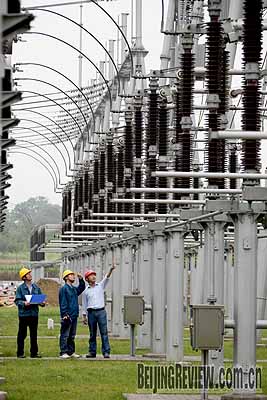| 
SUMMER PEAK June 20 to September 20 is the electricity peak-load period. China's electricity suppliers are ready to ensure power supply meets demand
Higher Inflation Tolerance
Chinese urbanites have a greater tolerance to high prices, are more prudent investors and more willing to buy insurance, compared with the previous quarter, according to a central bank survey in the second quarter.
In a poll of 19,600 people from 49 cities nationwide, 45 percent said the current price level was too high to tolerate. The figure was 4.2 percentage points lower than the previous quarter.
In addition, 51.6 percent said the price level was tolerable, up 4.1 percentage points from the previous quarter.
Only 16.8 percent believed investing in stocks or mutual funds was lucrative, 10.8 percentage points lower than the quarter earlier.
The good news for insurers was that more than 70 percent said in comparison with the previous quarter, they were now more willing to purchase policies.
Eyeing Westwards
China is to launch 10 key projects in the western regions this year in an effort to promote development of the vast area.
According to the National Development and Reform Commission, the 10 projects, with a combined budget of 436 billion yuan ($64.12 billion), are aimed at boosting the economic potential and social development of outlying regions.
These projects include new railway lines, airport expansion projects, and the building of hydropower stations, coalmines, gas and oil transmission tube lines, as well as public utility projects in the areas.
Steel Revamp
China's leading steel maker Baosteel said on June 24 that it would form a 35.86-billion-yuan ($5.12 billion) joint venture in Guangzhou with two domestic rivals.
Baosteel is to own 80 percent of the new company, with a 28.69-billion-yuan ($4.17 billion) investment, while Guangzhou Iron and Steel Enterprises Group (GISE) and Shaoguan Iron and Steel Group (SISG) will take a combined 20-percent stake with existing assets, Baosteel said in a statement to the Shanghai Stock Exchange.
The new venture, named Guangdong Iron and Steel Group, is expected to be established before August.
SISG is the country's 27th largest steel maker, while GISE ranks 35th. Both must eliminate obsolete facilities, since Guangdong Province vowed to cut its steel- making capacity by 10 million tons during the 2006-10 period.
Insurers Join Expressway Financing
Four of China's insurance companies have been given the green light by the country's insurance regulator to invest 16 billion yuan ($2.35 billion) in the Beijing-Shanghai express railway.
Sources from the China Insurance Regulatory Commission said that four asset management companies under Ping'an Insurance, Pacific Insurance, Taikang Life and Taiping Life will jointly set up a Beijing-Shanghai express railway equity investment project to raise the planned amount of capital.
In addition, the China Reinsurance (Group) Co., Generali China Life Insurance Co. and PICC will also act as partakers and beneficiaries of the project, with the China Construction Bank as the trustee and the China Development Bank as an independent supervisor.
Fixing Damaged Roads
The Ministry of Transport said on June 24 that it has earmarked 36 million yuan ($5.1 million) to repair roads damaged by recent flooding in south China.
The money will go to the provinces of Guangdong, Jiangxi, Hunan and Guizhou, and Guangxi Zhuang Autonomous Region, which suffered the most, a ministry statement said.
Downpours have caused floods in more than 20 provincial regions, killing at least 176 people and damaging roads, bridges and other facilities.
According to the ministry, floods had damaged 969 bridges and disrupted traffic on six expressways, 29 national highways and 260 provincial highways as of June 18.
No major congestion was reported, although there were regional traffic disruption in Jiangxi, Hunan, Yunnan and Zhejiang, the ministry said.
| 